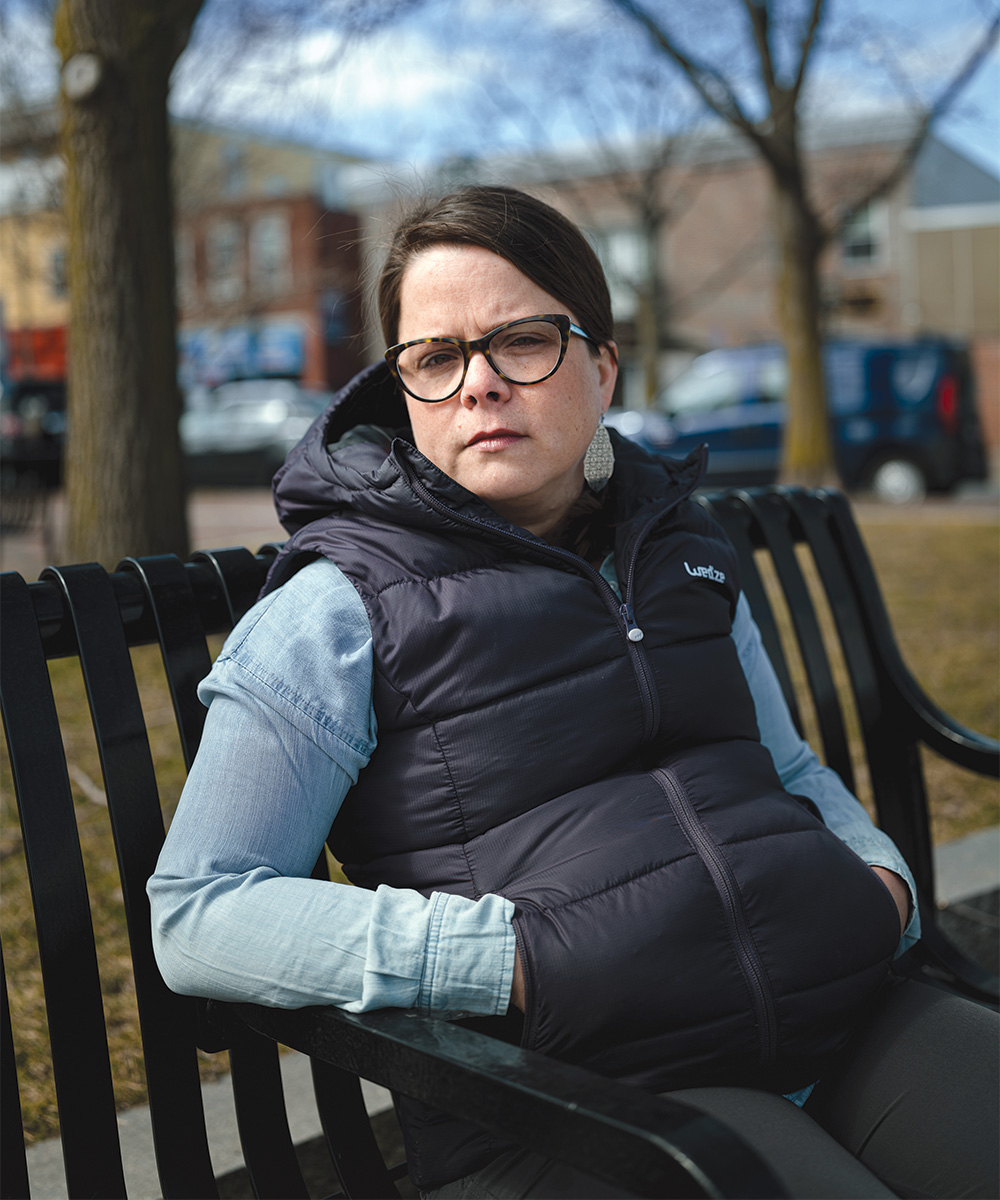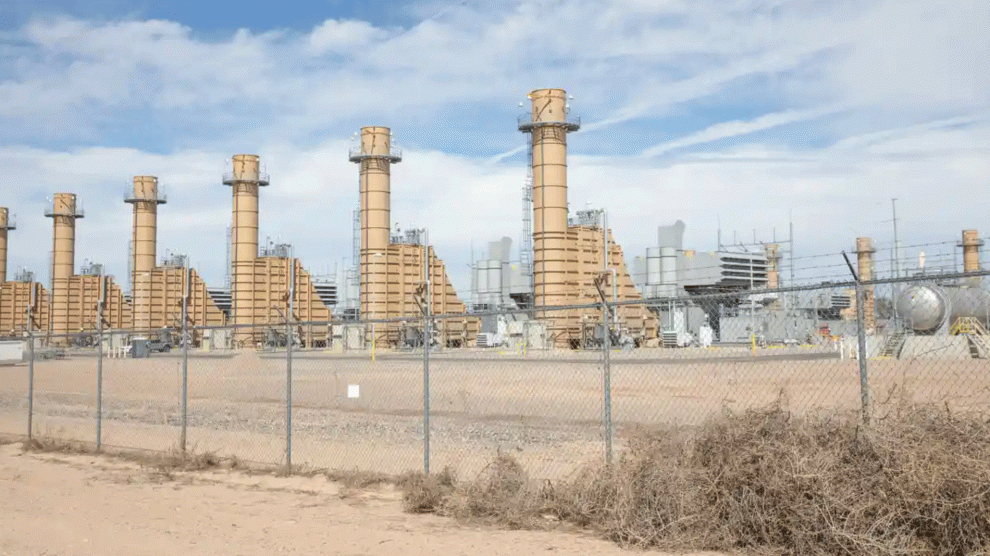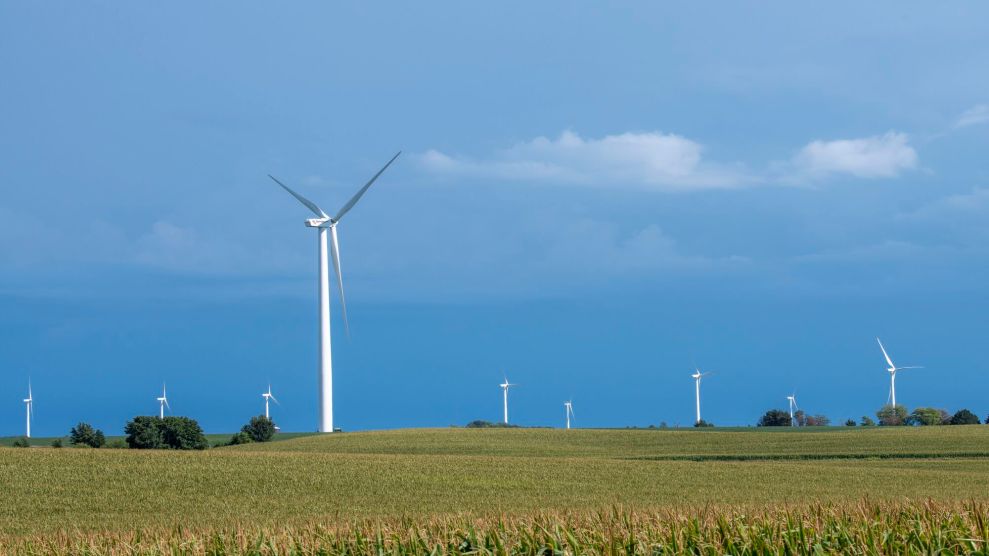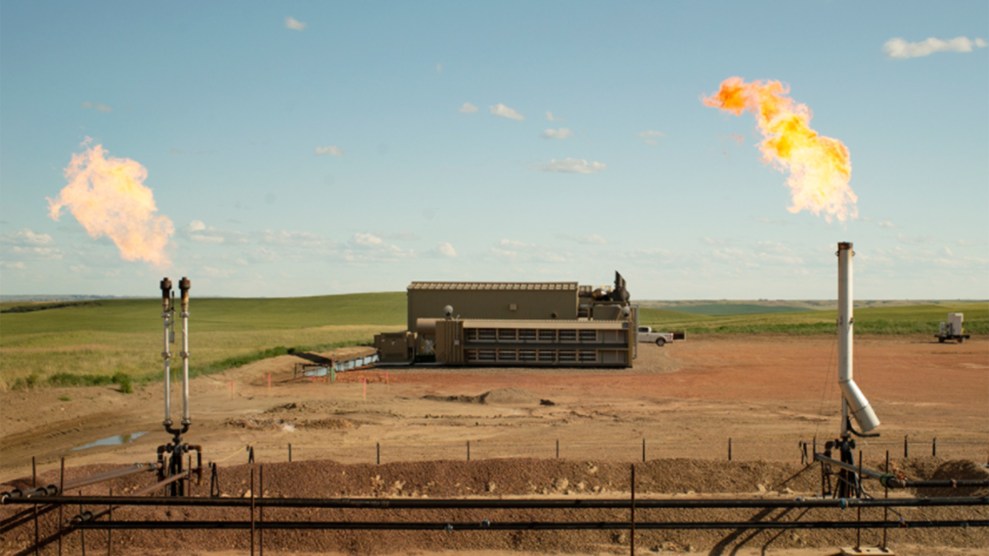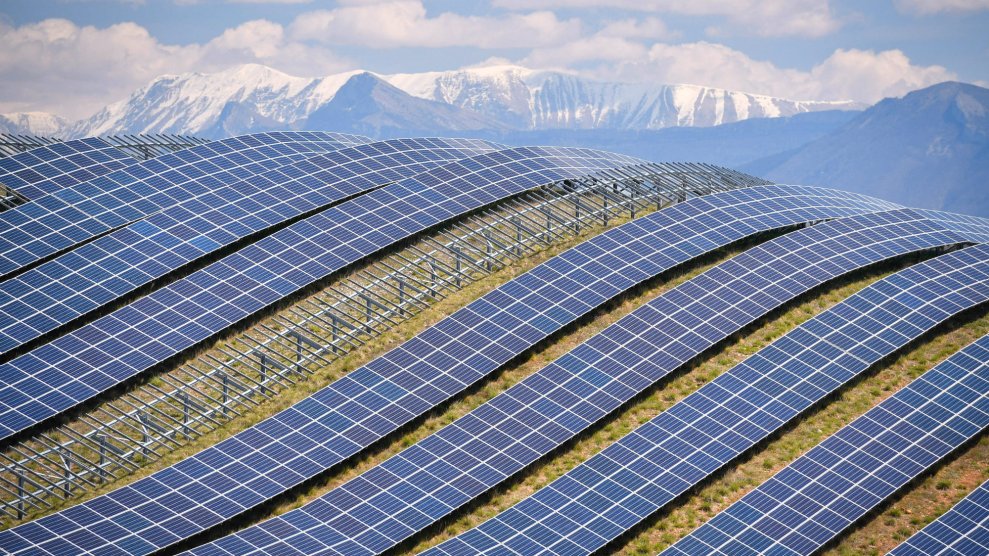The United States is on the brink of its most consequential transformation since the New Deal. Read more about what it takes to decarbonize the economy, and what stands in the way, here. Leer este articulo en español.
On a recent morning, researcher Dominick Dusseau offers a glimpse into the future of Chelsea, Massachusetts, a small, industrial city just across the Mystic River from Boston. On digital maps he displays over Zoom, great blue splashes cover large swaths of the city—areas where, by his calculations, climate-driven flooding is likely to occur. The maps depict a world where the locals who can least afford it will get hit the hardest.
Dusseau’s analysis is a collaboration between the city and his employer, the Woodwell Climate Research Center, a nonprofit founded by a prominent ecologist who sounded early alarms about the hazards of DDT and climate change. Its mission is to put actionable data into the hands of decision makers, which is why it doesn’t charge for the climate risk assessments it conducts for cities like Chelsea, whose working-class population of about 39,000 is predominantly Latino.
To create the maps, Dusseau measured the precise elevations relative to sea level at numerous locations around the city. Combining these measurements with Chelsea’s stormwater data, he modeled various crisis scenarios—what happens, for instance, when a big downpour coincides with a high tide or storm surge. A town with so much pavement, he explains, can’t easily absorb excess water. “There are pretty significant increases in the amount of rainfall that Chelsea is going to have to deal with,” he says. “It’s just a huge amount of flooding.”
He found that storms now forecast as once per century—events that would flood 14 percent of the city—are likely to happen every year by 2100. Notably, floodwaters may encroach on the enormous white drums that hold jet fuel for nearby Logan Airport and the location near Chelsea Creek where Eversource, the region’s utility, is building a new electrical substation against residents’ wishes. “By 2080, it’s heavily inundated—the entire coastline is pretty much underwater,” Dusseau says.
The Federal Emergency Management Agency’s flood maps for Chelsea look very different—Dusseau suspects that’s because FEMA relied on less-granular topographical data and ignored the effects of rainfall on storm surges, both “errors with real implications,” he says. City leaders are now leaning on the Woodwell findings to develop climate resiliency on the community’s terms. Amid a shortage of affordable dwellings, “lots of people live in crowded conditions or rent illicit spaces like basements,” notes Alex Train, the city’s director of housing and community development, and knowing which buildings are at risk “could determine whether someone survives an event or not.”
Chelsea, of course, is just one of countless threatened communities. The nonprofit First Street Foundation predicts that roughly a quarter of the nation’s critical infrastructure will be vulnerable to flooding in the coming decades. Where Chelsea stands out is in the foresight department: Since 2018, its city officials have been working with GreenRoots, a local environmental justice organization, to not only assess climate risks but enact solutions, including the nation’s first community-owned, cloud-based microgrid.
Across America, microgrids are having a moment. They vary in design and scope, but a microgrid is basically a relatively small, local system that can generate, store, and/or distribute electricity, and can function off of the main grid if need be. They can be public or private, and consist of anything from a couple of neighbors sharing a solar panel to a bitcoin mine powered by its own wind farm. Some military stations, hospitals, and universities have long hosted backup generators to safeguard against power outages. But whereas those systems mostly rely on fossil fuels, the builders of newer microgrids are increasingly looking to renewables, especially solar.
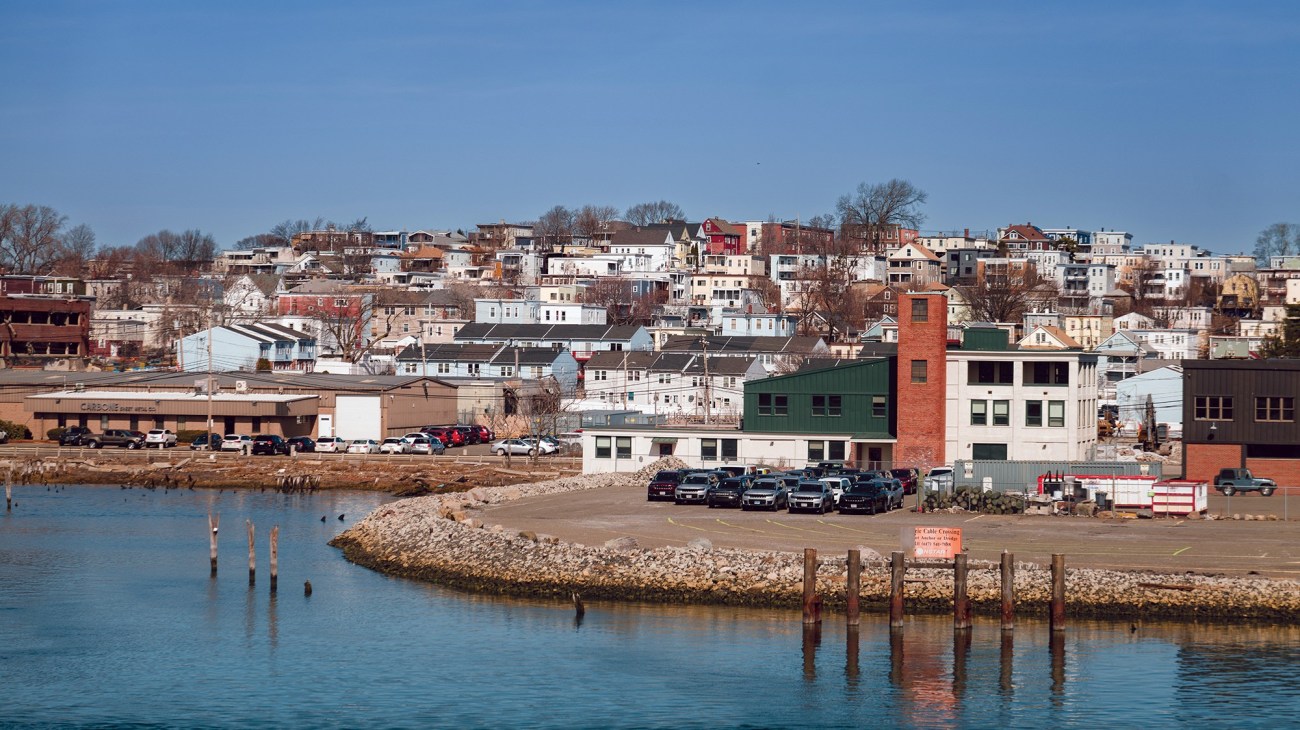
Chelsea as seen from across the creek in East Boston, both industrial communities vulnerable to flooding.
Ryan Christopher Jones
Until very recently, steep regulatory hurdles and utility interference made microgrids insanely difficult to build. But policy changes, technological improvements, and the plummeting cost of clean power are opening up some fresh possibilities. Some 460 operational microgrids have been installed in the United States and its territories since 2015, most in the handful of states that have taken steps to clarify connectivity rules, cut red tape, and actively encourage their deployment.
Chelsea’s modest microgrid will equip key sites with limited backup power in emergencies. The first phase consists of installing batteries or solar panels at four locations: City Hall, the 911 dispatch center, the police department, and Janus Apartments, a low-income housing complex. Phase two will expand the project to other essential buildings with the aim of supporting a local health center and other affordable housing for vulnerable residents, including seniors. The ultimate goal, says 38-year-old María Belén Power, an organizer and former GreenRoots associate executive director who helped inspire and lead the city’s microgrid effort, is “social and community resilience.”
Power was born in Nicaragua to a family deeply committed to social justice and workers’ rights. Soon after moving to the United States to study sociology, she got involved in helping immigrants brace for ICE raids, doing things like “preparing families to know what to do if their kids came home from school and their parents weren’t there” because they’d been taken.
She eventually moved to Chelsea, where she took a job supporting workers’ rights, and later organizing people around public housing issues. She steered clear of the environmental movement. “I thought it was for white people and for people who have money to care about trees,” she says. “There were a lot more urgent fights.” But over time, she began to draw connections with the causes she most cared about. “It’s the same folks fleeing violence in countries in Central and Latin America who are not getting paid fair wages, who are also living with some of the worst impacts of climate crisis,” she now says. When GreenRoots was first invited, as part of a coalition of like-minded nonprofits, to participate in a microgrid feasibility study, Power didn’t understand the excitement. But after speaking with members of Chelsea’s Puerto Rican community—who’d seen family on the island languish without power for months after 2017’s Hurricane Maria—Power realized that “this is a way to model what energy democracy looks like on the ground.”
She wasn’t the only one who faced a learning curve. Tom Ambrosino, then Chelsea’s city manager, recalls sitting through a couple of overwhelming early meetings “where we were trying to understand what a microgrid was. Honestly, I’m still not sure I clearly understand what it is,” he jokes.
Given the convoluted mix of state and federal regulations, each step of the design process required extensive research. Ambrosino wishes they’d had a clear statutory framework to guide them, but when Power “gets something in her mind that she wants to accomplish, don’t bet against it,” he says. The team secured $75,000 for its feasibility study, which concluded in 2020. To buy and install the battery systems, they cobbled together $850,000 from two state resiliency programs, and the city itself fronted the remaining $500,000. When the microgrid goes online, hopefully late this year, it will operate as a municipal service, with an oversight board consisting of community members.
The project ran into hurdles almost immediately, however. It was impossible, for instance, to share electricity across property boundaries, because, as Sean Garren, chief programs officer at the energy nonprofit Vote Solar, explains, “the wires and the ability to transfer electricity is part of the monopoly utilities are granted.” So the coalition opted to start with large-scale batteries at important locations. Unable to string power lines between microgrid nodes, the team found an innovative workaround: a remote, cloud-based control system that lets the operator manage far-flung installations simultaneously. You may have heard of the idea of using electric vehicles as distributed batteries, feeding power into the system when demand is highest. Chelsea’s microgrid operates on the same concept: The city’s cloud controller will direct its batteries to suck up cheap off-peak power. Later, when rates are high, it will sell any excess electricity back to the grid at a profit. If the main grid fails, the controller will immediately switch the buildings over to backup battery power—up to 10 hours at City Hall and 16 hours at the police department.

GreenRoots volunteer Nohemi Lobato, pictured in front of the David Fitcher mural “Chelsea Resilient,” was among the local activists pushing for a microgrid project.
Ryan Christopher Jones
The combined storage capacity of the batteries—more than 500 kilowatts—makes Chelsea’s microgrid large enough to participate in wholesale electricity markets, which should provide enough revenue to finance its operation and maintenance. “As opposed to many clean energy projects that take local capital outside of the community, we’re seeking to monetize power,” Train says, “and reinvest in residents’ daily lives.”
Similar projects show that the finances can work. In Sterling, Massachusetts, 37 miles to the west as the crow flies, a 2-megawatt battery system combined with a 3-megawatt solar array saves the municipal utility an estimated $400,000 per year and is predicted to pay for itself in seven. Chelsea’s microgrid, in its initial, limited state, will take six to 10 years to break even, according to its planners.
The project has garnered interest from nearby communities. (Boston’s Chinatown is developing its own microgrid in cooperation with the same nonprofit coalition.) “We have a lot of sporadic citywide outages,” Train explains, and a microgrid can help in such scenarios. But the high bar Chelsea has had to clear, despite having the Woodwell report and a motivated team in its corner, doesn’t bode well for other small towns looking to avert the ravages of climate change. A key part of that challenge lies in how the US power grid is managed.
What we call “the grid” is actually three separate, massive regional energy networks known as the Eastern, Western, and Texas interconnections, plus a host of smaller power networks within them. When the United States was electrifying during the 1930s, utility companies were granted “natural monopoly” status because of the enormous upfront costs—the high-voltage transmission lines that connect these networks to one another, and to major power plants, are prohibitively expensive. This special treatment allows a single company to be its region’s sole electricity provider and pass along to customers the cost of building and maintaining plants, power lines, and substations. In practice, many utilities make money not by selling electricity but by building new infrastructure with a guaranteed rate of return.
This dynamic has long complicated local and national decarbonization efforts. “A system that would provide you with reliable electricity without the use of a utility is a threat to that monopoly,” says Garren of Vote Solar. Faced with rooftop solar buildouts and microgrid installations, he says, some utilities “throw up barriers at every stage” and even use ratepayer money to lobby politicians and regulators on behalf of shareholders—and against renewable energy projects and candidates who support them. (See Big Utilities Are “Diabolical, Man!)
Such influence peddling helps explain why so many states let their utilities put clean energy suppliers through such a grueling bureaucratic process. Eversource has taken “quiiiite a while” to approve Chelsea’s application to connect to the grid, Train says—a year after the city applied, the utility still hadn’t given officials an ETA. (“We have issued two agreements and are ready for scheduling construction activities but have not completed all the interconnection agreements,” Eversource noted in an email.) More than 8,000 energy projects nationwide were in similar limbo at the beginning of 2022, as a surge in connection requests from renewables projects contributed to a worse-than-usual utility bottleneck.
With electricity generation still accounting for about one-third of US emissions, transforming these industry dynamics—revamping workforces, policies, and infrastructure to accommodate all the new power coming online—is crucial to meeting President Joe Biden’s goal of a carbon-free power sector by 2035. One key step is to change the way utilities make money, says Lauren Shwisberg, who oversees research on the clean energy transition at the nonprofit Rocky Mountain Institute. Hawaii recently did just that, she notes, now basing utility compensation on a “performance based model” that factors in its success in deploying renewables. But such changes don’t happen on their own. “It needs to be a concerted choice by utilities and state public utility commissions,” Shwisberg says.
In 2020, the Federal Energy Regulatory Commission finally approved Order 2222, which requires grid operators to let distributed energy producers—from homeowners to small commercial outfits—trade electricity on wholesale markets. It’s also what will allow Chelsea to combine its batteries and solar panels into a single, larger power entity that can command a higher price per kilowatt-hour of electricity it sells back to the grid.
The distributed energy market is poised to explode thanks to the Inflation Reduction Act, which includes, critically, about $3 billion to increase the grid’s capacity to move power around. It also includes tax credits to spur further investment in microgrids and other renewables projects. Even before the IRA passed, Wells Fargo announced a large solar-and-battery project in New Mexico, and private equity giant the Carlyle Group financed construction of a microgrid at New York City’s JFK airport. (See sidebar: Snapshots From a Clean-Energy Future.)
In California, PG&E now encourages microgrids in some rural areas and fire zones to reduce the risk of its transmission lines sparking devastating wildfires. Newer technologies such as blockchain microgrids—which allow individuals to trade energy directly, bypassing a central authority like a utility—are being piloted in Brooklyn. In Florida, Syd Kitson, a former NFL player from New Jersey, teamed up with the regional utility to develop Babcock Ranch, an 18,000-acre planned community that opened in 2018. The ranch is powered entirely by a solar farm that produces more energy than the town consumes. During last fall’s Hurricane Ian, Babcock’s lights stayed on while most of the surrounding county lost power.
But the ability of affluent communities like Babcock to hedge against climate extremes raises the question of who will be left behind. For many municipalities, even getting accurate data on their climate risk is a major hurdle. “This is information that local governments need, that will keep people safe,” notes Dave McGlinchey, chief of external affairs for Woodwell. And even a town as proactive as Chelsea has to navigate the bureaucratic thicket of securing funds to pay for what’s needed.
Congress coughed up $1 billion last year for a competitive FEMA grant program meant to prioritize climate-resilience projects in communities like Chelsea. But environmental outlet E&E News reported that lawmakers from both parties had directed FEMA to channel $154 million of those grants “to some of the richest and whitest communities in their districts.” The previous year’s biggest gift—$50 million—went to Menlo Park, a wealthy Silicon Valley haven with a median household income of nearly $180,000.
Political connections aside, rich communities are more likely to be aware of the grants available to them, and to have the resources and personnel needed to land them. “It’s a foot in the door problem,” Power says. In 2022, FEMA more than doubled its budget for local resilience grants, and simplified the process a bit, but the paperwork remains “extremely prohibitive for smaller, under-resourced municipalities,” Train says.
The pressures on America’s grid are only intensifying amid the push to electrify everything. As demand for power soars and the share of renewables grows, grid operators need to ensure enough energy will be available. Green energy is notoriously variable: The sun disappears behind clouds and wind speeds wax and wane, making it harder to predict how much power will be available at any given time.
Battery storage systems like Chelsea’s can help as a backup, and producing more power locally limits transmission-related losses and eases dangerous congestion on high-voltage lines. But neither the utilities nor the regional organizations that coordinate grid operations have a coherent plan for how distributed energy projects can be harnessed to maximize the efficiency of the overall system.
The need to get this sorted is urgent. This past winter, as natural gas supplies faltered during the Russia-Ukraine crisis, New England’s grid regulator warned of potential blackouts. Eversource, too, cited grid reliability problems as a reason to build a new substation on Chelsea’s border. Eversource says the substation—which converts high-voltage electricity from transmission lines into the lower voltages used by homes and businesses—is needed to protect the residents of nearby East Boston, who are among the network’s “most vulnerable” customers, and who rely on an existing Chelsea substation that’s already running at full capacity.
The new substation, however, was vehemently opposed by the residents of both communities who feel besieged by industrial development and polluted waterways, and think state and utility officials view them as an afterthought. It didn’t improve matters when, in 2017, the state energy board held a meeting on the substation before a primarily Spanish-speaking crowd. A translator was present, but only to interpret public testimony for the board members—not in the other direction, which the board’s counsel deemed “too disruptive.” That led to a 2020 federal civil rights complaint for the exclusion of non-English speakers from the process.
Eversource got its approval in February 2021, despite entreaties from high-profile politicians such as Sen. Elizabeth Warren. A month later, Massachusetts passed a new climate law that codified environmental justice protections. Anyone proposing a new energy project would now have to consider existing environmental burdens (and their cumulative impact) on the neighborhoods in question, a requirement that might have stopped the substation in its tracks. Power fought hard for the new law, though the timing felt ironic.
In November 2022, the energy board voted to let Eversource bypass 14 state and local environmental permits, fast-tracking its substation construction—even though, in an advisory ballot question the previous November, nearly 84 percent of Boston voters had deemed the location inappropriate. The utility, in an ironic twist, is planning its own large-scale battery storage program for touristy Outer Cape Cod. This rankles Power: Why not put battery storage in Chelsea and locate the new substation in a less-burdened area—at nearby Logan Airport, for instance, which consumes a lot of power and has better flood protections. Boston’s public radio station has reported, meanwhile, that the utility wants power customers to foot the bill for a $1.4 million community benefits package to mitigate the substation’s impacts.
“Eversource has taken a very different approach depending on the communities,” Power says. “Communities that lack political power, like Chelsea and East Boston—they don’t really have to respond to us, because we don’t have the political power that people in Cambridge do. I do think that race and class are very much a factor.” (In a reply, Eversource cited a need for new electrical infrastructure “in communities of all demographics.”)
The substation fight, says Power, shows why it’s so important for government officials to give people a meaningful say in decisions that affect their health and livelihoods. In 2018, the streets around the new substation location were flooded with seawater; this past December, a powerful storm system caused extensive citywide flooding and swamped a park around the corner from the substation site. “This isn’t us putting up a fight because we just want to raise hell—although we do like raising hell,” Power says. “It’s about saying, ‘Work with the community on safer infrastructure.’”
That’s what she plans to do, anyway. Power was appointed in March 2021 to a Biden administration council that advises federal agencies on environmental and climate justice issues. “We need investment in communities that are most vulnerable,” she says, “but we also need distributed generation—as many community solar projects as possible.”
Otherwise, the brunt of climate change will be borne by people like Mayli Ochoa, who lives with her husband and two adult daughters in a multifamily building built, like much of Chelsea’s affordable housing, in an area prone to inundation. The families here, she says, have scant resources for when things go wrong. In 2020, her relatives in Honduras experienced flooding from back-to-back hurricanes, heightening her concern about her situation in Chelsea.
Ochoa has spent years as a volunteer, working with GreenRoots on housing issues as the city grapples with gentrification. “A majority of Chelsea residents,” many of them undocumented, she says, “are afraid to go find help.”
She can relate. In 2021, Covid-19 left her comatose in the hospital for 40 days, and ongoing health issues make it difficult to work. The police recently came to her door, assuming she was illegally subletting to her daughters. (She wasn’t.) “I’m afraid,” she said, tearing up. But “we are working so hard, fighting for the community.”
For Power, all these problems—housing, health, poverty, climate—are connected. Now, as the microgrid nears fruition, she has a new gig that will allow her to make that case on a bigger stage. As Massachusetts’ new undersecretary of environmental justice and equity, she fully intends to engage with concerned citizens like Ochoa and treat them as partners in building a more secure future for communities across the state. “We’ve seen some of those solutions that came from the ground up,” Power says. “In Chelsea!”
